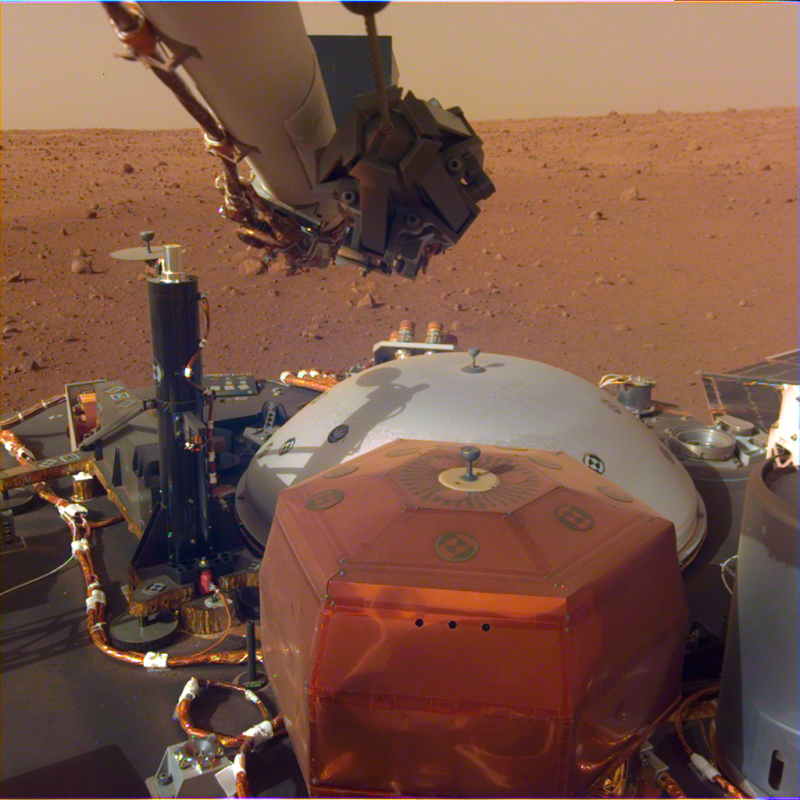To say Mars is a bizarre planet might be something of an understatement. It has nearly no atmosphere, has an unstable liquid metal core that causes it to wobble on its axis constantly, and as a frozen desert, is an oxymoron in itself. As if Mars wasn’t strange enough, data from NASA’s InSight Lander (RIP) has now revealed that the red planet is spinning faster and faster every year.
The increasing spin went unknown until a research team found evidence of acceleration through InSight’s RISE (Rotation and Interior Structure Experiment) instrument. That same team, led by radio scientist Sebastien Le Maistre of the Royal Observatory of Belgium, who is also the principal investigator of RISE, had previously found that the core of Mars is most likely a glob of molten metal. Looking further into RISE data from InSight’s first 900 days on Mars, they saw that the planet’s spin was accelerating by a fraction of a millisecond per (Earth) year, or about 0.76 milliseconds. Martian days are gradually growing shorter. But why?
What lies beneath—or above
RISE’s main objective was to see how much Mars wobbled as its orbit was pushed and pulled by the gravity of the Sun. This would determine whether the core was more likely to be solid or liquid. However, RISE also had another task, which was measuring the length of a Martian day. Days on Mars, known as sols, are about a half-hour longer than Earth days at 24 hours and 37 minutes. RISE measured both the rotation rate and wobbling of Mars with reflected radio waves. When it received a radio signal from NASA’s Deep Space Network (DSN), it would reflect those waves right back at Earth. The difference between the frequency of the signal sent out by the DSN and the signal that bounced back to Earth told the InSight team how the lander was moving along with Mars.
Changes in the frequency of reflected radio waves revealed both wobbles in orbit and how long a day lasted on the red planet, and RISE measured changes in day length more precisely than ever, with five times more accuracy than the Viking landers had. There was also another way RISE found evidence that Martian days were getting slightly shorter. It also tracked shifts in carbon dioxide at the poles, where CO2 will sublimate as the planet warms up in the spring and summer or condense as the planet cools down in the fall and winter.
Ice, ice baby
While we know why Earth’s rotation has been slowing down over billions of years and making our days longer, scientists are not positive about the exact reason the spin of Mars is accelerating and shortening its days. But there's a reasonable chance that it has something to do with changes in the red planet's ice caps.
When Martian ice caps lose carbon dioxide ice to sublimation during the warmer months, regions that had been covered become mostly ice-free. Le Maistre and his team suggest that post-glacial rebound or ice accumulation (or both) would bring the mass of Mars closer to its axis as it rotates, though in different ways. It can happen when carbon dioxide from the atmosphere condenses into ice that accumulates at the polar ice caps, which are extremely close to the axis. Alternatively, post-glacial rebound deforms the planet as ice sublimates and land mass moves back into the gaps left behind.
Alternatively, the researchers think it is possible for Mars to accelerate through core-mantle coupling, which involves momentum from its liquid core being transferred to the mantle.
“Evidence of a slow acceleration in the Martian rotation rate [could] be the result of a long-term trend either in the internal dynamics of Mars or in its atmosphere and ice caps,” they said in a study recently published in Nature.
Finding such minuscule variations in the data was a tedious undertaking. The researchers needed to wait a painfully long time for enough data to come in while the lander was still operational, and when they finally had that data, they needed to rule out all possible causes of noise that could interfere with their results, such as water and the solar wind, both of which could have slowed down the reflected radio signals from InSight that were traveling to Earth from Mars.
Even though InSight met its demise in a dust storm, Le Maistre hopes to keep learning more from the data and potentially determine the culprit behind days on Mars growing shorter.
Nature, 2023. DOI: 10.1038/s41586-023-06150-0



3175x175(CURRENT).thumb.jpg.b05acc060982b36f5891ba728e6d953c.jpg)

Recommended Comments
There are no comments to display.
Join the conversation
You can post now and register later. If you have an account, sign in now to post with your account.
Note: Your post will require moderator approval before it will be visible.